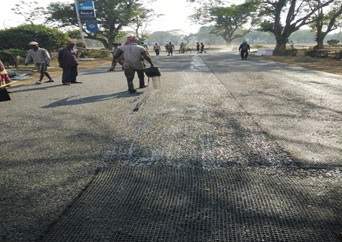
Military Engineering Services (MES) selects our Geogrid technology for pavement strengthening and secure protection at one of their bases in Kalaikunda, Kharagpur.
The air force station entry road at Kalaikunda was suffering from severe interconnected cracks. Increased traffic meant the pavement was not able to survive for its intended design life. As a result, the pavement had developed surface cracks that had further deteriorated and become large potholes.
The client decided the pavement needed a durable rehabilitation solution.
It was necessary to repair the damaged pavement by adding an asphalt layer to increase the pavement’s load carrying capacity so it could take the weight of the traffic and offer the required serviceability. Overlays are still the most common option for extending the life of distressed pavements. While special asphalt mixes can be specified and thicker overlays improve performance, a geosynthetic interlayer can be placed over the distressed pavement prior to the overlay to create an economical, long-lasting overlay system.
Overlay on its own not enough
However, rehabilitating cracked roads simply by overlaying is rarely a durable solution. The cracks under the overlay rapidly propagate through to the new surface. This phenomenon is called reflective cracking. A geosynthetic interlayer contributes to the life of the overlay by providing stress relief and/or reinforcement.
For reinforcing the pavement, MacGrid AR 10A.7 was suggested for the interface of the Built-up Spray Grout (BUSG) and Bituminous Macadam (BM) layer. Tack coat is applied over the BUSG layer before laying the MacGrid to ensure proper adhesion of the MacGrid to the surface.
MacGrid AR 10A.7 is a reinforcing geogrid material specially developed for pavements. It consists of glass fibre strands arranged in a grid structure with a pressure sensitive adhesive.
The Many Benefits of MacGrid AR
Reduced reflective cracking: MacGrid AR can reduce reflective cracking in asphalt surfaces caused by the movement, bending and shearing of cracks in underlying asphalt layers or cement-bound substrates. The Stress Absorbing Membrane Interlayer (SAMI) effect can also reduce strain on the surface.
Control of differential settlement cracking: Combining MacGird AR in new unbound aggregate layers can mitigate longitudinal cracking caused by differential settlement between new and existing lanes on widened roads.
Reduced surface rutting: MacGrid AR interlocks with the asphalt to restrict lateral movement of particles, reducing permanent strains and surface rutting, particularly in low stiffness mixes subjected to slow and heavy wheel loading at high temperatures.
Longer operational life: By delaying the onset and development of cracking, MacGrid AR can increase overall pavement performance and as a result, extend operational life.










